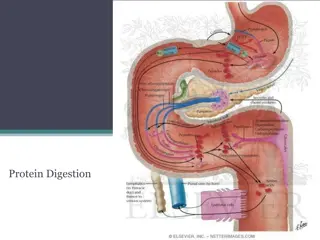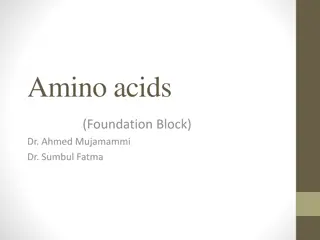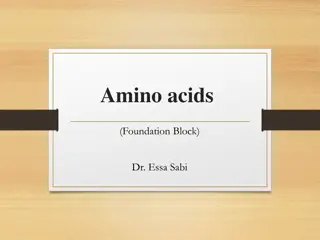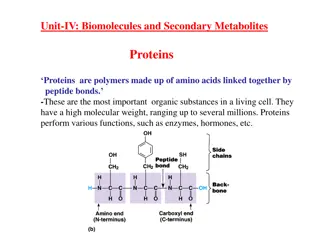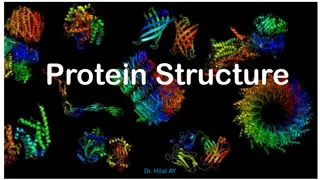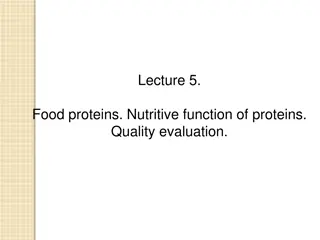Structure of Proteins: Amino Acids and Protein Organization Levels
The 20 amino acids in proteins are linked by peptide bonds, forming the primary structure that encodes the protein's unique shape. Genetic diseases can result from abnormalities in amino acid sequences affecting protein folding and function. Protein structure analysis involves primary, secondary, tertiary, and quaternary levels. The quaternary structure refers to proteins with multiple polypeptide chains that can function independently or cooperatively. Explore the complexity of protein organization and its implications for disease diagnosis and research.
Download Presentation

Please find below an Image/Link to download the presentation.
The content on the website is provided AS IS for your information and personal use only. It may not be sold, licensed, or shared on other websites without obtaining consent from the author.If you encounter any issues during the download, it is possible that the publisher has removed the file from their server.
You are allowed to download the files provided on this website for personal or commercial use, subject to the condition that they are used lawfully. All files are the property of their respective owners.
The content on the website is provided AS IS for your information and personal use only. It may not be sold, licensed, or shared on other websites without obtaining consent from the author.
E N D
Presentation Transcript
Structure of Proteins The 20 amino acids commonly found in proteins are joined together by peptide bonds. The line is sequence of the linked amino acids contains the information necessary to generate a protein molecule with a unique three - dimensional shape. The complexity of protein structure is best analyzed by considering the molecule in terms of four organizational levels: primary, secondary, tertiary, and quaternary (Figure 8-11). 1. PRIMARY STRUCTURE OF PROTEINS The sequence of amino acids in a protein is called the primary structure of the protein. Understanding the primary structure of proteins is important because many genetic diseases result in proteins with abnormal amino acid sequences, which cause improper folding and loss or impairment of normal function. If the primary structure s of the normal and the mutated proteins are known, this information may be used to diagnose or study the disease.
4. QUATERNARY STRUCTURE OF PROTEINS Many proteins consist of a single polypeptide chain and are defined as monomeric proteins. However, others may consist of two or more polypeptide chains that may be structurally identical or totally unrelated. The arrangement of these polypeptide subunits is called the quaternary structure of the protein. Subunits are held together primarily by non-hydrophobic interactions). Subunits ma y either function independently of each other or may work cooperatively, as in hemoglobin, in which the binding of oxygen to one subunit of the tetramer increases the affinity of the other subunits for oxygen.



